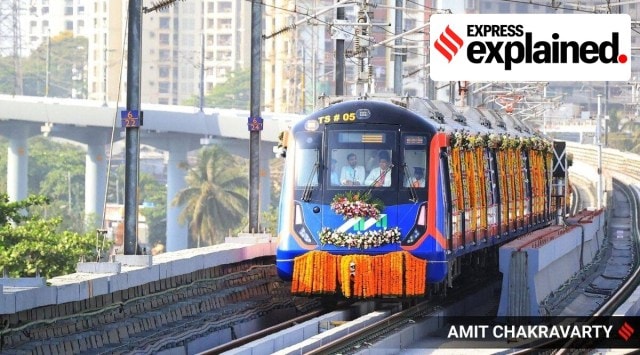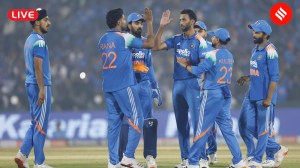Mumbai Metro’s new Lines 2A and 7 could ease traffic woes, here’s what to expect
To be inaugurated by Prime Minister Narendra Modi on January 19, the new Mumbai metro lines could help take the load off the local train. How is the project estimated to ease congestion? We explain.
 In April 2022, then Chief Minister Uddhav Thackeray flagged off Phase 1 of the new Mumbai Metro lines. (Express Photo by Amit Chakravarty)
In April 2022, then Chief Minister Uddhav Thackeray flagged off Phase 1 of the new Mumbai Metro lines. (Express Photo by Amit Chakravarty) On January 19, Prime Minister Narendra Modi will inaugurate two new Mumbai metro lines, 2A and 7, named the yellow line and red line. The new routes will cater to offices and residential areas located at Western Express Highway (WEH) and Link Road in the suburbs of the city.
The officials said the trains will be open for use on January 20, running at an average frequency of every 10 minutes. With the commissioning of the second phase, commuters can travel between Andheri and Dahisar on eastern and western sides of the suburbs without a halt. The first train from Andheri west (Line 2A) will be at 5:55 am and the last train will be at 9:24 pm. On Line 7, the first train from Gundavali (Andheri E) will start from 6 am and the last train will be at 9:24 pm.
Mumbai’s first metro line, which runs through the Versova-Andheri-Ghatkopar areas and connects the central and western suburbs of the city, was opened for public use in 2014. In April 2022, Metro Lines 2A and 7, with a total length of over 35km, saw the opening of a partial stretch from Aarey to Dhanukarwadi under Phase 1.
Preparing for UPSC? Use CRACKUPSC20 code here to get an extra 20% discount on Indian Express subscription.
What is the aim of Metro Lines 2A&7?
Currently, commuters of suburban Mumbai travel largely by local train or BEST buses, and others use means of private transportation, such as taxis, auto rickshaws or private vehicles. However, the local train often sees a big crowd during the morning and evening rush hours. The crowded situation has also caused deaths in a few instances.
In an attempt to ease this burden on existing systems through additional modes of public transportation, Metro Line 2A will run from Dahisar to DN Nagar, Andheri West, and Metro Line 7 from Dahisar East to Andheri East. Once these two elevated corridors are operational, they are expected to help reduce the crowds on the local train by around 10 to 15%.
Similarly, the Mumbai Metropolitan Region Development Authority (MMRDA), the authority implementing the project, expects a reduction in traffic by 25% with the functioning of both the lines and a reduction in travel time by 75%.
As per the MMRDA, the new lines will carry 3 lakh passengers per day, expected to go up to 11.31 lakh passengers by 2031. Largely indigenously-built metro rakes of six coaches, each with a carrying capacity of 380 persons per coach. Bharat Earth Movers Ltd (BEML) manufactured the new metro coaches.
What are the stations on the 2A and 7 Metro lines?
There are 30 stations on both these metro lines. Line 2A comprises 17 stations: Andheri (West), Lower Oshiwara, Oshiwara, Goregaon (West), Pahadi Goregaon, Lower Malad, Malad (West), Valnai, Dahanukarwadi, Kandivali (West), Pahadi Eksar, Borivali (West), Eksar, Mandapeshwar, Kandarpada, Upper Dahisar and Dahisar (East).

Line 7 has 13 stations: Gundavali, Mogra, Jogeshwari (East), Goregaon (East), Aarey, Dindoshi, Kurar, Akurli, Poisar, Magathane, Devipada, RashtriyaUdyan and Ovaripada.
What was the timeline for the project’s completion?
When the work order was awarded in May 2016, the project’s estimated cost was Rs 12,000 crore, with an expected completion date in 2019. The Metro Line 2A project completion cost is Rs 6, 410 crores and the Line 7 project completion cost is Rs 6,208 crore. The funding agencies for both metro lines are Asian Development Bank and the National Development Bank.
The MMRDA was supposed to start commercial operations in December 2020, but work’s progress was halted due to the Covid-19 lockdown. Later when the work resumed, the deadline was postponed to March, then May, then October and then December 2021. Later in April this year, Phase 1 opened to the public.
Then the two elevated metro lines were in the final stage of testing at the end of December, including supervision by the Commission of Metro Rail Safety (CMRS). Once the safety clearance certificate was in place, commercial operations were to be allowed. The final and last CMRS certification included supervision of the tracks, signalling, electrical systems and civil works before opening the corridor for passengers. A safety check is done by the competent authority.
Prior to this, the MMRA obtained a provisional certificate for a trial run from Research Designs and Standards Organisation (RDSO).
- 01
- 02
- 03
- 04
- 05





































